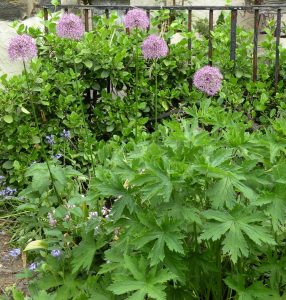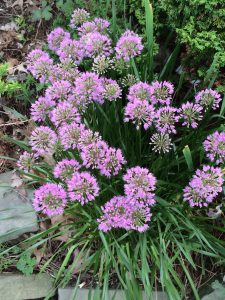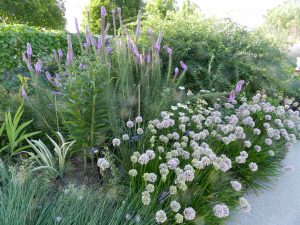
Allium ‘Purple Sensation’ behind Geranium psilostemon foliage in my garden in early June
When the word Allium is spoken, the first image that comes to mind is a big purple ball that towers over a little child but there are hundreds more species, hybrids, and cultivars in existence, from short to tall and bloom time from spring through fall.
The most important thing to remember, if you want Allium to recur from year to year, is the nature of their natural habitat: sunny sites with well-drained soil. Heavy clay soils, like the ones in Northeast Ohio, increase susceptibility to root rot organisms; therefore, it is incumbent upon us to amend the soil with a product like Turface which is an enlarged aggregate.

Allium ‘Millenium’ closeup in my hill garden in late July
Allium ‘Millenium’is an asset to any type of perennial garden or as a border in a landscape bed but it is particularly useful in a pollinator garden because it is especially attractive to butterflies and bees.
This relative of the common onion has been named the 2018 Perennial Plant of the Year by the Perennial Plant Association. ‘Millenium’ was selected for its mid-summer flowering with masses of rosy-purple, spherical blooms that last at least a month and its uniform habit of neat, shiny green leaves that remain attractive all year. Even when the color is gone, the beige balls are still attractive. In addition, it is drought tolerant, deer and rabbit resistant (as is any member of the onion family), and hardy in zones 4-9 and possibly to zone 3. Although many Allium seed heavily, ‘Millenium’ does not.
Since this allium has a fibrous root structure, it is easily divisible in early spring or fall.
This lovely perennial partners well with short goldenrods such as Solidago ‘Little Lemon’ that will be a bit taller and bloom slightly later, thus extending the food season for pollinators.

Allium ‘Millenium’ in my back garden in early August.

Allium ‘Millenium’ at the Des Moines Botanical Garden in late July.
I have planted mine in front of a dwarf pink rose and next to a yellow sedge. The color echoes that of the flowers of Agastache ‘Golden Jubilee’. At the Des Moines Botanical Garden, a mass of it is planted in front of one of the tall Liatris but it would also look great in front of the shorter Liatris ‘Kobold’.
This virtually no-maintenance perennial takes center stage during the summer when many gardeners are reluctant to venture out. Will its breath-taking beauty entice you into the garden in spite of the heat?


0 Comments